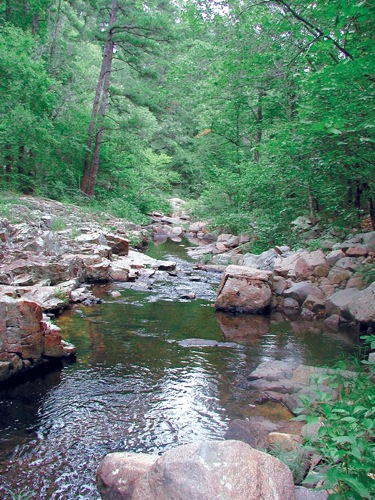
Courtesy Pickle Springs Natural Area
Otherworldly rock formations, the rolling Ozark Mountains and abundant wildlife make Missouri an ideal destination for outdoor-lovers.
Across the Show Me State, spring ushers in the pinks and purples of dogwoods and redbuds woven into forested hillsides. Dramatic migrations of pure-white snow geese bookend the warmer months. And in any season, trails for all ability levels give your group an opportunity to step off the motorcoach and be immersed in the state’s natural beauty.
Pickle Springs Natural Area
Ste. Genevieve
Springtime brings blooming wild azalea and wildflowers at Pickle Springs Natural Area; fall erupts in extraordinary color. This deep, forested gorge contains a natural spring, plus geological formations and plants that are found in few other spots in the state.
An easy two-mile walking loop maintained by the East Ozark Audubon Society skirts waterfalls, rock shelters, a double arch, towering bluffs, canyons and amazing rock outcrops.
“I always recommend Pickle Springs because it’s a wonderful yet easy trail,” said Stephanie Bell, director of tourism for the city of Ste. Genevieve. “
www.visitstegen.com
Squaw Creek National Wildlife Refuge
Mound City
Snow geese swirling above the wetlands at Squaw Creek National Wildlife Refuge create a sight and sound like no other. Nature’s spectacular show takes place in early spring when about 1 million migrating snow geese stop to rest in the Mound City area. More than a half-million birds come through in the fall.
Located on the Mississippi Flyway, the 7,350-acre sanctuary provides a respite for large concentrations of geese, waterfowl and bald eagles. A 10-mile road loops the refuge, providing excellent opportunities for bird-watching.
“Six pull-offs have scopes and interpretative signs so that groups can get a closer look at the waterfowl,” said refuge manager Ron Bell. “In addition, there are scopes along a 350-foot-long boardwalk, which takes people out to the edge of the marsh.”
Four hiking trails allow further exploration. The Eagle Overlook trail connects the refuge’s two largest wetlands on a 1.5-mile walk. The Loess Bluff’s half-mile climb ascends 200 feet on rock steps. The Munkers Trail starts at headquarters and goes by a late-1800s homestead site, where a number of original historic buildings remain intact.









